Nikon Nikkor AF-S Micro 60 mm f/2.8G ED
3. Build quality
You can notice that the Nikkor, although quite huge, is not the heaviest instrument in this group. Only the 70 mm Sigma is bigger than it. It should be remembered, though, that the Nikkor doesn’t change its dimensions and is a sealed, airtight construction.
The photo below presents the tested lens positioned between the Pentax 100 mm f/2.8 WR Macro and the Nikkor 1.8/50D.
Please Support UsIf you enjoy our reviews and articles, and you want us to continue our work please, support our website by donating through PayPal. The funds are going to be used for paying our editorial team, renting servers, and equipping our testing studio; only that way we will be able to continue providing you interesting content for free. |
- - - - - - - - - - - - - - - - - - - - - - - - - - - - - - - - - - - - - - - - - - - - - - - -
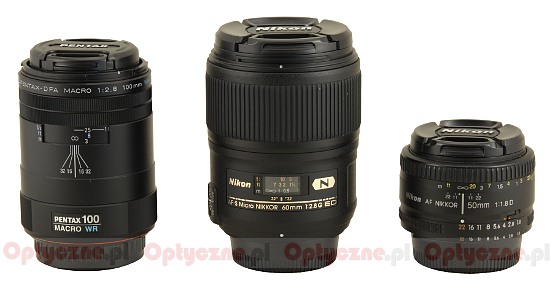 |
For a start we see a metal bayonet mount with contacts which surrounds a rear element 24 mm in diameter. The element is almost on the same level as the mount and it doesn’t move so there will be no problems with sucking in dust or dirt.
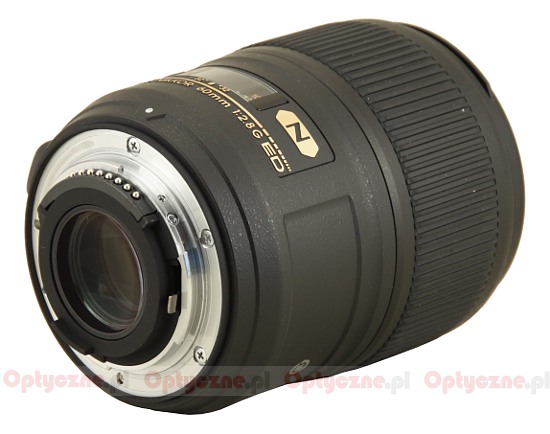 |
Behind the mount, already on the lens’s barrel, we find a white dot which helps attaching the lens to a body. On the left, looking from the top, we see a focus mechanism mode switch (M/A-M). Not far from that switch there is a plate with the name and parameters of the lens which surround a distance scale situated behind a window. The scale is expressed in meters and feet (and then in inches); it also features the mapping scale marks. Below the scale you can also find depth of field markings by f/32 aperture.
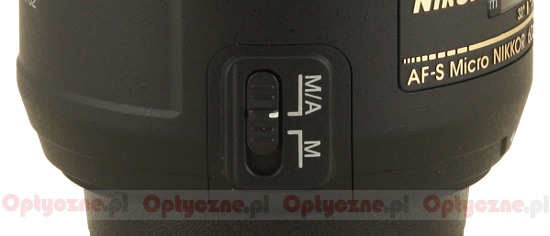 |
On the opposite side of the lens we can see a white inscription „Nikon” and below “SWM ED IF Aspherical Micro 1:1 62”, „Nano Crystal Coat” and „MADE IN THAILAND”.
The rest of the barrel consists practically of a big, almost 4 cm wide, manual focus ring. It is rubber-padded and ribbed to ensure a firm grip and comfortable work. The ring is well-damped and moves smoothly. Running through the whole scale takes a 180-degree turn.
Behind the ring you can only find some narrow projections of the mount to which you attach a hood. The front element is immobile and rather small because only 28 mm in diameter. It is surrounded by a non-rotating filter thread, 62 mm in diameter. When it comes to the inner construction the lens consists of 12 elements positioned in 9 groups. Two elements are aspherical and one was made of low-dispersion ED glass. Some optical elements were covered by a special Nano Crystal Coat layer which is to ensure good colour rendering and to damp down flares. Inside, you can also find a circular aperture with nine diaphragm blades which can be closed down to f/32.
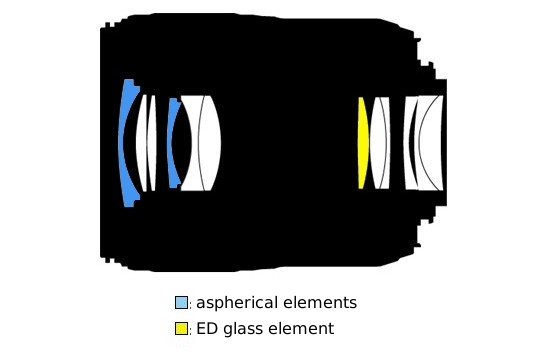 |
The buyer gets both caps, a hood and a soft pouch included in box.
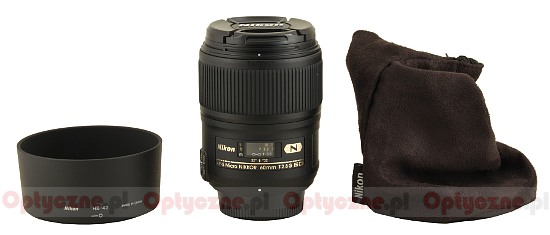 |






